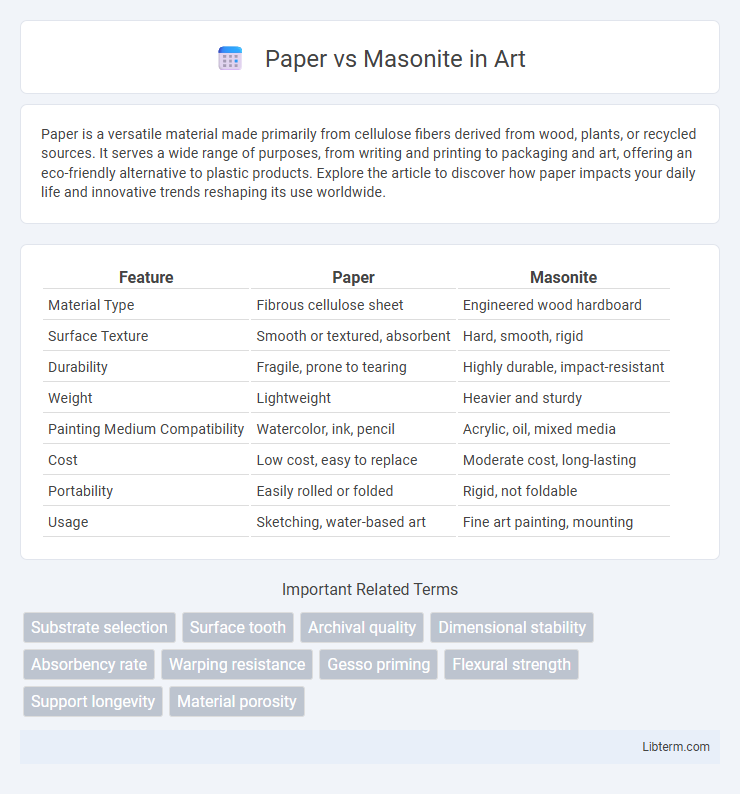Paper is a versatile material made primarily from cellulose fibers derived from wood, plants, or recycled sources. It serves a wide range of purposes, from writing and printing to packaging and art, offering an eco-friendly alternative to plastic products. Explore the article to discover how paper impacts your daily life and innovative trends reshaping its use worldwide.
Table of Comparison
| Feature | Paper | Masonite |
|---|---|---|
| Material Type | Fibrous cellulose sheet | Engineered wood hardboard |
| Surface Texture | Smooth or textured, absorbent | Hard, smooth, rigid |
| Durability | Fragile, prone to tearing | Highly durable, impact-resistant |
| Weight | Lightweight | Heavier and sturdy |
| Painting Medium Compatibility | Watercolor, ink, pencil | Acrylic, oil, mixed media |
| Cost | Low cost, easy to replace | Moderate cost, long-lasting |
| Portability | Easily rolled or folded | Rigid, not foldable |
| Usage | Sketching, water-based art | Fine art painting, mounting |
Introduction: Understanding Paper and Masonite
Paper is a thin, flexible material made primarily from cellulose fibers derived from wood pulp, widely used for writing, printing, and packaging. Masonite, also known as hardboard, is a dense engineered wood product created by pressing and steaming wood fibers into rigid panels, known for its strength and durability. Understanding the structural differences between paper and Masonite highlights their distinct applications, with paper suited for lightweight tasks and Masonite ideal for construction and furniture making.
Material Composition and Properties
Paper is composed primarily of cellulose fibers derived from wood pulp, offering lightweight, flexible, and biodegradable properties, ideal for packaging and printing applications. Masonite, also known as hardboard, is manufactured from compressed wood fibers bonded with resin under high heat and pressure, resulting in a dense, rigid, and durable panel with superior impact resistance and moisture stability. The significant difference in material composition contributes to Masonite's enhanced structural strength and longevity compared to the more fragile and porous nature of paper.
Historical Background and Common Uses
Paper, originating from ancient China around 105 AD, revolutionized communication and record-keeping with its lightweight, versatile nature. Masonite, developed in the 1920s by William H. Mason, is a dense hardboard made from wood fibers, prized for its durability and smooth surface. Common uses of paper include printing, packaging, and writing, while Masonite finds applications in furniture construction, wall paneling, and art canvases.
Strength and Durability Comparison
Masonite exhibits superior strength and durability compared to paper due to its dense fiberboard composition, offering enhanced resistance to impact, moisture, and wear. Paper, being lightweight and porous, lacks the structural integrity needed to withstand prolonged stress or environmental factors. Masonite's robust construction makes it ideal for applications requiring lasting durability and load-bearing capacity.
Environmental Impact and Sustainability
Masonite, made from wood fibers bonded under high heat and pressure, offers higher durability and potential for reuse compared to conventional paper products, which are often single-use and decompose quickly. Paper production generally consumes less energy and water than Masonite manufacturing, but generates more waste and requires frequent reforestation to maintain supply. Sustainable sourcing of raw materials, recycling programs, and biodegradability are critical factors that influence the overall environmental impact of both materials.
Cost Analysis: Paper vs Masonite
Masonite generally costs more upfront than paper due to its durable fiberboard composition, making it a longer-lasting option for construction and crafting projects. Paper remains the most economical choice, especially for temporary uses or single-use applications, but it lacks the structural strength of Masonite. When factoring in longevity and durability, Masonite offers better value over time despite higher initial expenses.
Workability and Ease of Use
Masonite offers superior workability compared to paper due to its rigid structure, allowing for easy cutting, shaping, and sanding with standard woodworking tools. Paper, while flexible and lightweight, lacks this durability and is prone to tearing or wrinkling, limiting its practical applications in crafts or construction. The ease of use of Masonite makes it ideal for sturdy projects requiring precision, whereas paper suits lightweight, disposable, or temporary uses.
Applications in Art and Construction
Paper excels in detailed art projects such as sketching, watercolor, and printmaking due to its versatility and smooth texture. Masonite, a type of engineered wood, provides a durable and stable surface ideal for painting, furniture making, and wall paneling in construction. The choice between paper and Masonite depends on project durability requirements and surface texture preferences.
Maintenance and Longevity
Masonite offers superior durability and requires minimal maintenance compared to paper, making it ideal for projects needing long-term resilience. While paper is prone to tearing, moisture damage, and frequent replacement, Masonite resists warping, water damage, and can last for decades with simple cleaning. Its hardness and water resistance significantly extend the lifespan of surfaces and create a low-maintenance alternative to traditional paper materials.
Choosing the Right Material: Key Considerations
Choosing between paper and Masonite depends on the intended use, durability needs, and finish quality. Masonite, a hardboard made from pressed wood fibers, offers superior strength, moisture resistance, and smooth surface ideal for painting or construction, while paper provides affordability, lightweight handling, and ease of customization for packaging or crafting. Evaluating factors like environmental exposure, load-bearing requirements, and aesthetic preferences ensures selection of the right material for optimal performance and cost-efficiency.
Paper Infographic

 libterm.com
libterm.com